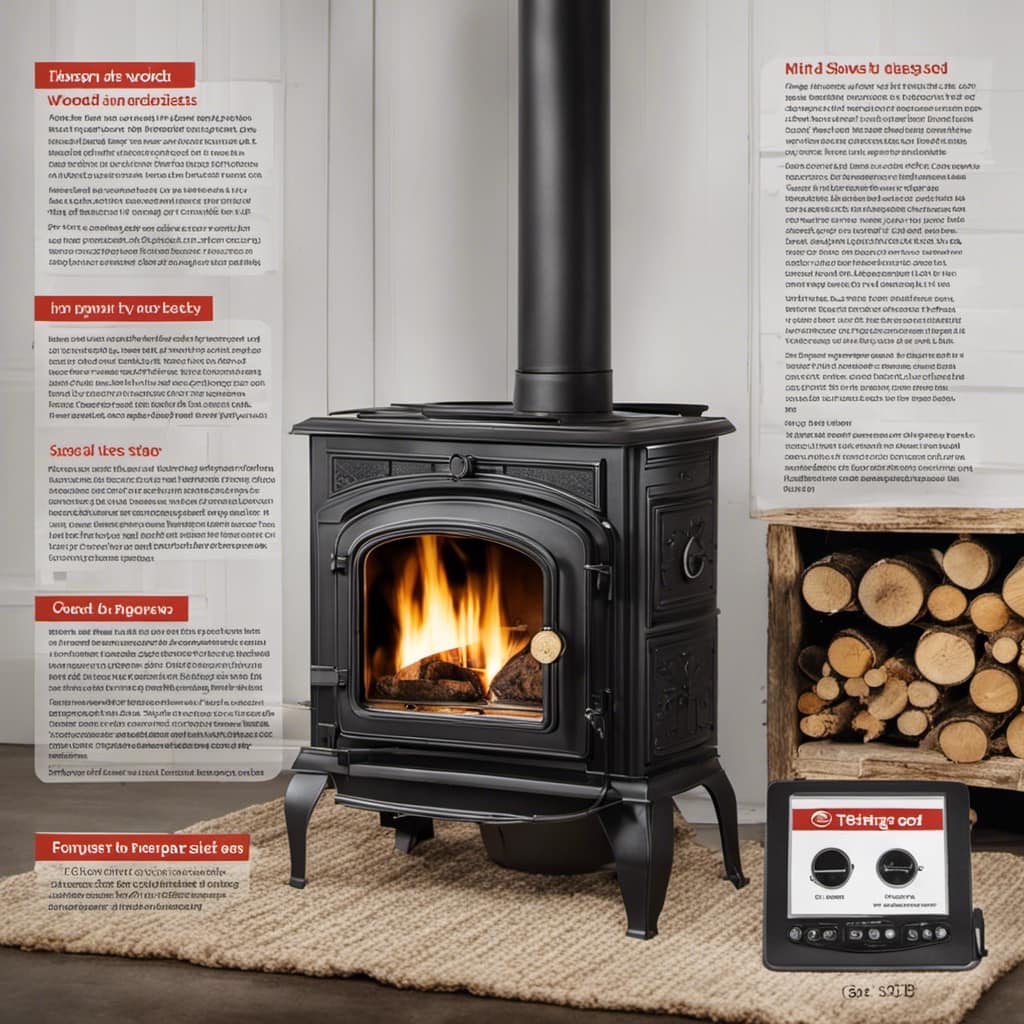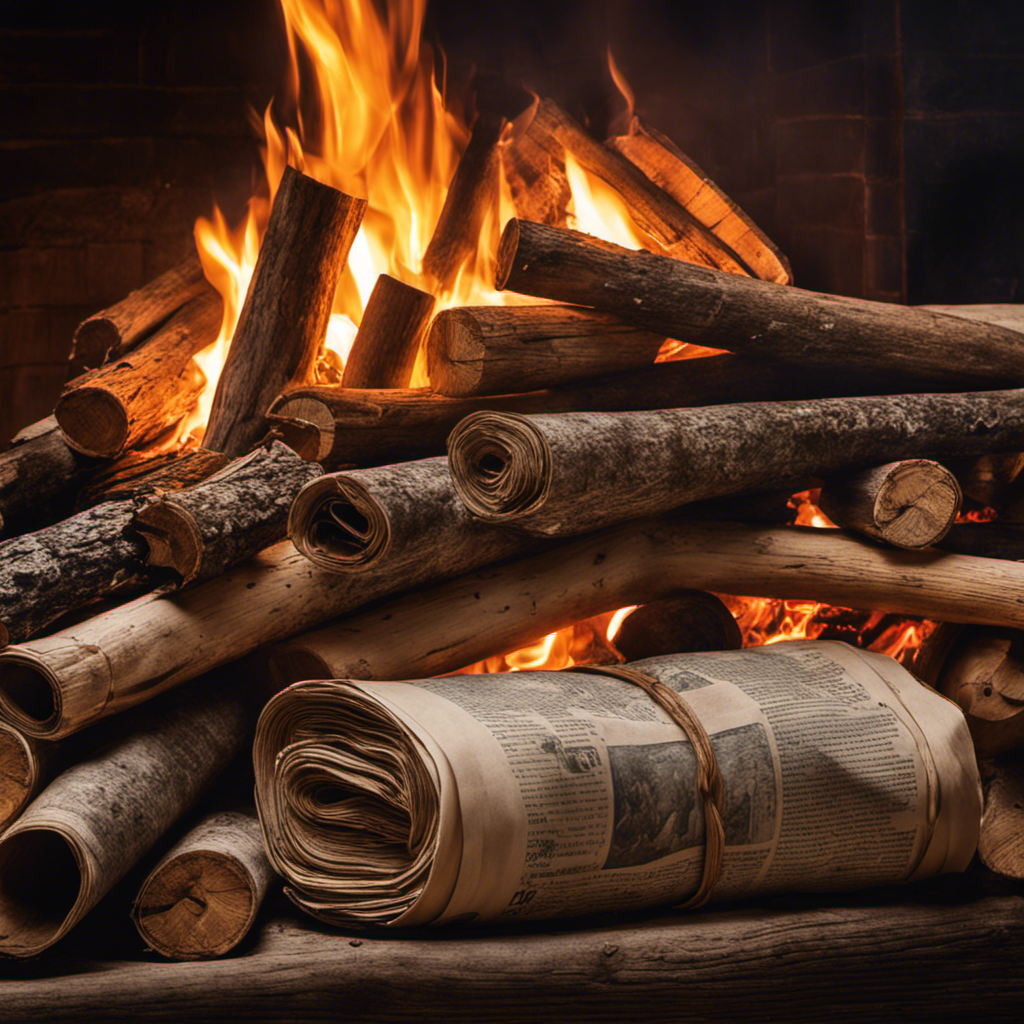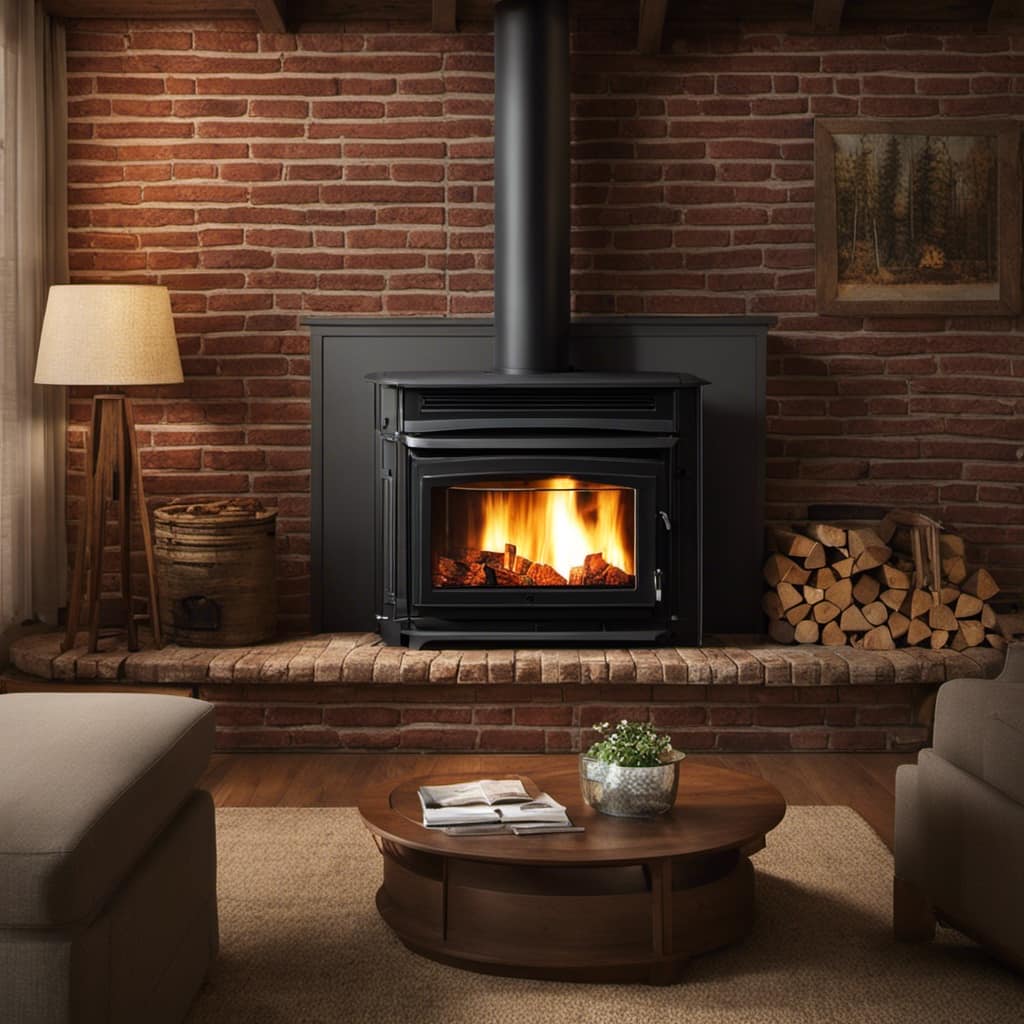
Cleaning the glass on a wood stove may seem like a challenging chore, but fear not! I have created the perfect guide to streamline the process and make it incredibly simple.
From understanding why clean glass is crucial to gathering the right supplies and using natural cleaning solutions, I’ll walk you through every step.
Say goodbye to stubborn stains as we scrub them away and finish off with a sparkling, polished shine.
Get ready to maintain clean glass for future cozy fires. Let’s get started!
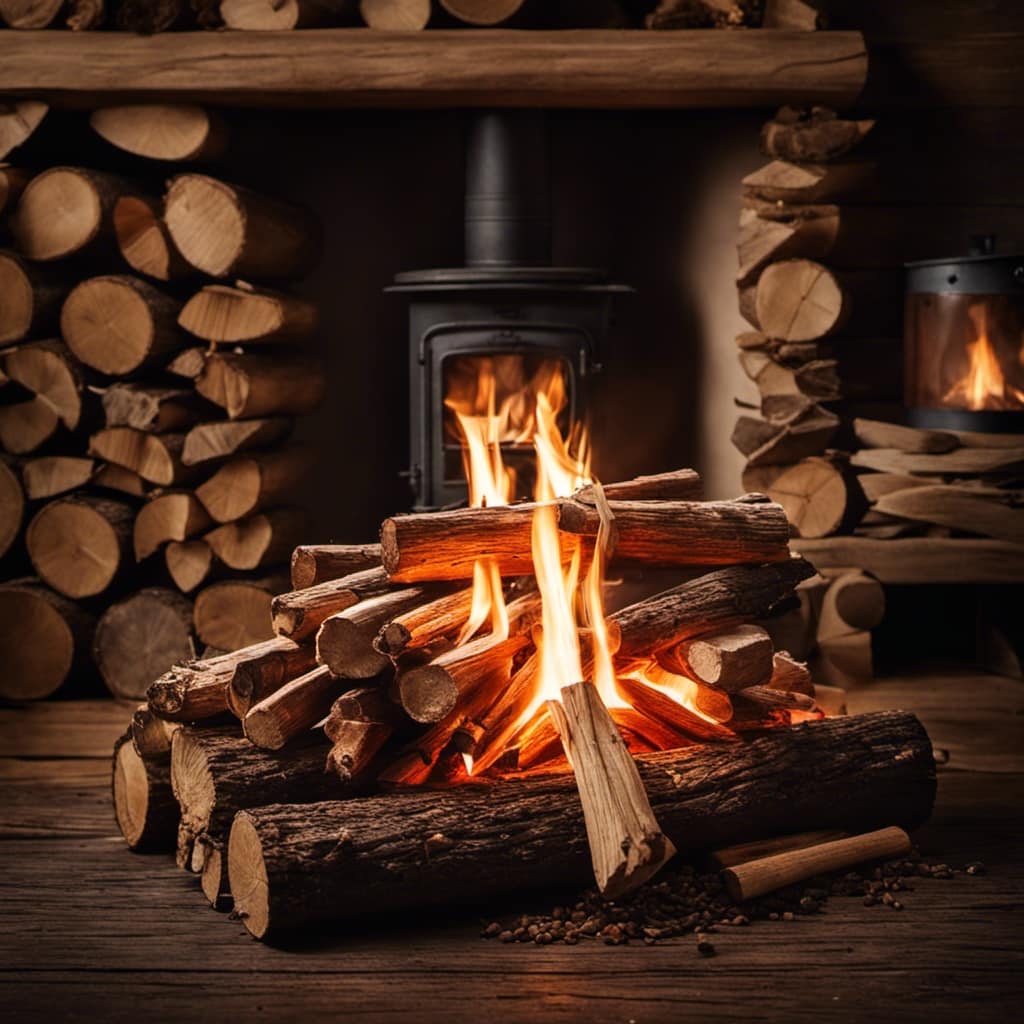
Key Takeaways
- Clean glass ensures a clear view of the fire, enhancing the visual experience.
- Using natural cleaners like vinegar and lemon juice is safe, effective, and environmentally friendly.
- Gently wiping the glass in circular motions with a vinegar and water solution removes residue without causing scratches.
- Microfiber cloth is the ideal material for drying and polishing the glass, leaving a streak-free and shiny finish.
Understanding the Importance of Clean Glass
I find it crucial to understand the importance of clean glass on a wood stove.
Regular maintenance of the glass not only ensures a clear view of the fire, but it also plays a vital role in the overall performance and efficiency of the stove. When the glass is dirty or covered in soot, it restricts the flow of heat into the room. This means that the stove has to work harder to produce the desired level of warmth, resulting in increased fuel consumption and higher energy costs.
Cleaning the glass regularly also helps to maintain the aesthetic appeal of the stove. A clean and clear glass door enhances the visual experience of the fire, creating a cozy and inviting atmosphere in the room. Additionally, it allows you to monitor the fire more effectively, ensuring that it’s burning efficiently and safely.
When it comes to cleaning the glass, using eco-friendly cleaners is highly recommended. Traditional household cleaners often contain harsh chemicals that can be harmful to both the environment and your health. Eco-friendly cleaners, on the other hand, are made from natural ingredients that are safe and non-toxic. They effectively remove soot and grime from the glass without leaving behind any residue or unpleasant odors. By using eco-friendly cleaners, you not only protect the environment but also safeguard your own well-being.
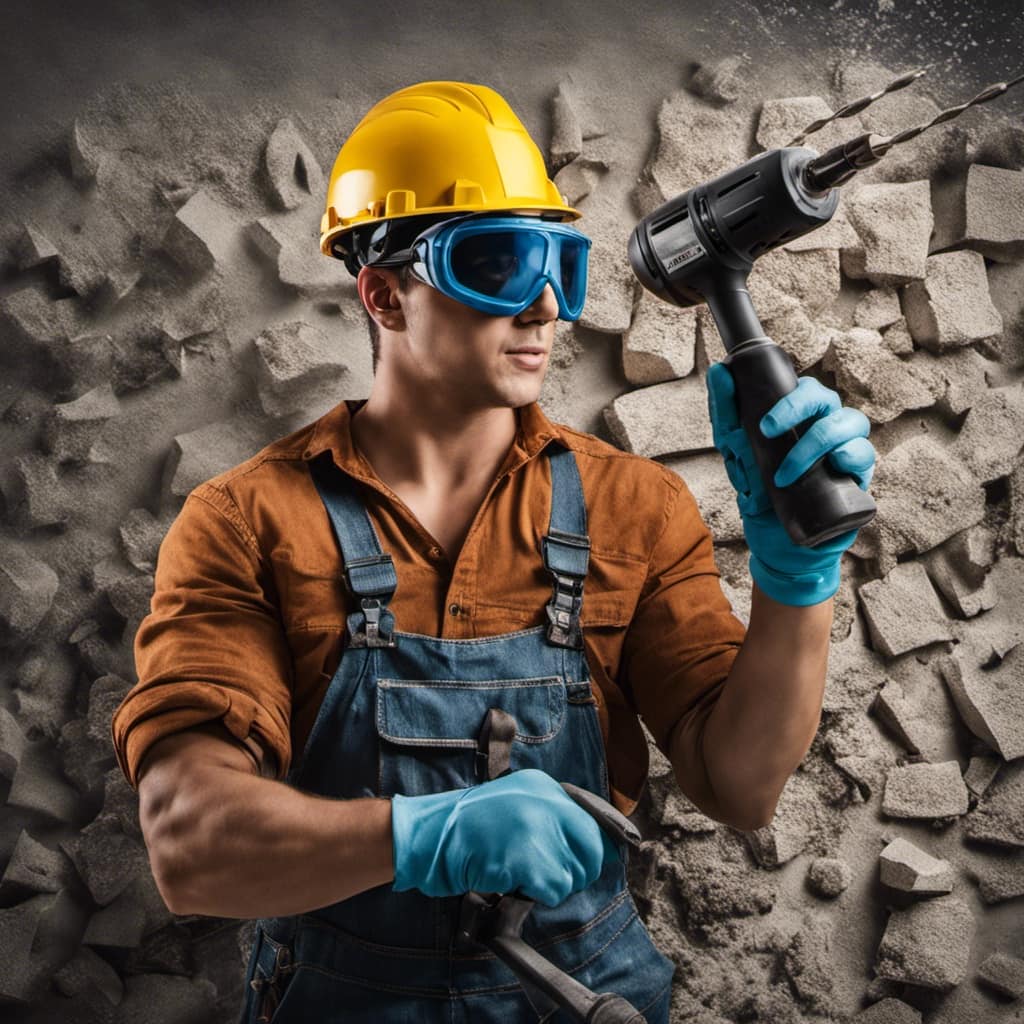
Gathering the Necessary Supplies
To get started, I’ll need a cloth, vinegar, and water to clean the glass on my wood stove. Cleaning the glass on a wood stove is essential to maintain its efficiency and aesthetic appeal. Over time, soot buildup can accumulate on the glass, obstructing the view of the fire and reducing the stove’s heating capacity. Therefore, it’s crucial to regularly clean the glass using effective techniques.
Firstly, I prepare a solution by mixing equal parts vinegar and water in a spray bottle. Vinegar is a natural cleaning agent that helps to break down the soot and remove stubborn stains. Next, I carefully open the stove door and ensure that it’s cold before proceeding. I spray the vinegar and water solution onto a clean cloth, making sure it’s damp but not soaked.
Using the damp cloth, I gently wipe the glass in circular motions, focusing on areas with heavy soot buildup. It’s important not to scrub vigorously, as this can scratch the glass surface. Instead, a gentle and consistent pressure is applied to remove the soot effectively.
Once the glass is clean, I use a dry cloth to wipe away any excess moisture and leave a streak-free finish. It’s crucial to avoid using abrasive cleaners or harsh chemicals, as they can damage the glass and affect its clarity.

Preparing the Glass for Cleaning
To prepare for cleaning, I gather the necessary supplies, such as vinegar, water, and a clean cloth.
Before I start cleaning the glass on my wood stove, I make sure to follow a few pre-cleaning steps to ensure the best results. These steps are crucial in removing soot buildup effectively and preventing any damage to the glass.
Here are the pre-cleaning steps I take:
-
Inspect the glass: I carefully examine the glass to identify any cracks, chips, or other damage that may require special attention during the cleaning process.
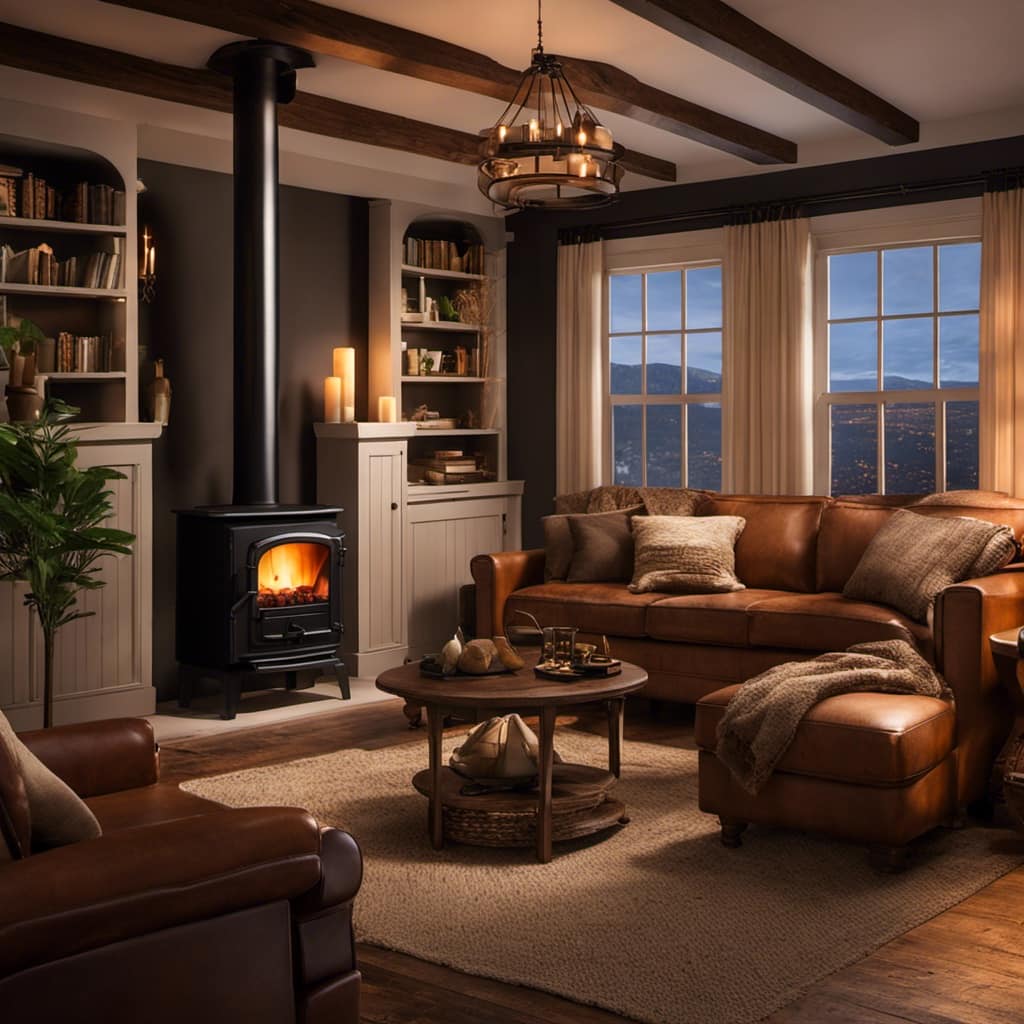
-
Protect the surrounding area: I place a protective covering over the floor and nearby furniture to prevent any accidental spills or damage.
-
Allow the stove to cool down: It’s important to wait until the stove is completely cool before attempting to clean the glass. Cleaning hot glass can cause it to crack or shatter.
-
Remove any loose debris: I use a soft brush or cloth to gently remove any loose soot or ash from the glass surface.
-
Prepare the cleaning solution: I mix equal parts of vinegar and water in a spray bottle. This solution is effective in breaking down and removing stubborn soot buildup.
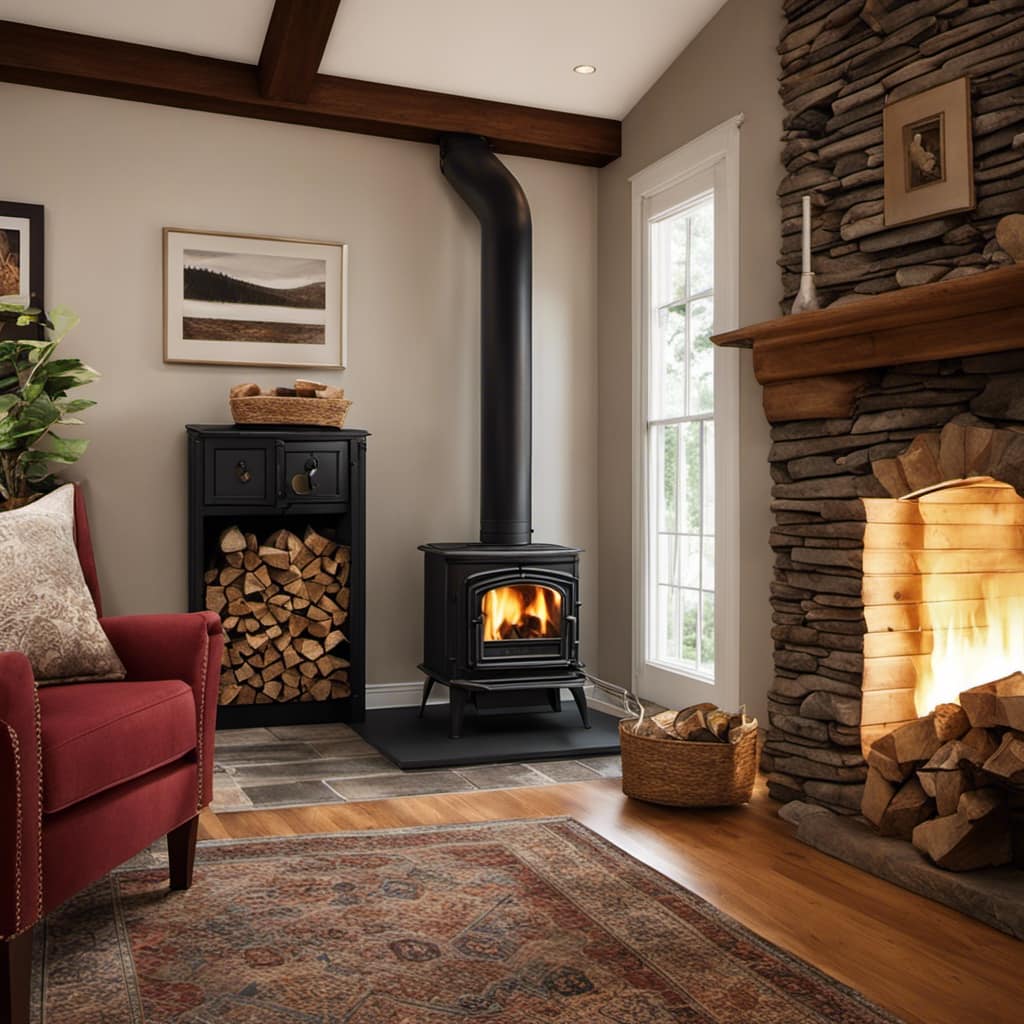
Using Natural Cleaning Solutions
When it comes to cleaning solutions, I prefer to use natural alternatives for their effectiveness and eco-friendly nature.
Natural solutions such as vinegar, baking soda, and lemon juice have proven to be highly effective in removing residue and providing a shine.
In the following points, I’ll outline the specific methods and benefits of using these natural cleaning solutions for a thorough and sustainable cleaning experience.
Vinegar for Removing Residue
I found that using vinegar is effective for removing residue from the glass on my wood stove. Vinegar is a versatile cleaning agent that’s safe, inexpensive, and readily available.

Here are some reasons why vinegar is a great alternative cleaning solution for removing residue:
- Vinegar is a natural and non-toxic option, making it safe to use around my family and pets.
- It’s environmentally friendly, as it doesn’t contain any harsh chemicals or produce harmful fumes.
- Vinegar is highly effective in breaking down and dissolving stubborn residue on the glass, leaving it clean and streak-free.
- It’s a cost-effective solution, as vinegar is much cheaper than commercial cleaning products.
- Using vinegar also helps to reduce waste, as it eliminates the need for single-use cleaning wipes or paper towels.
Baking Soda Scrubbing Method
The baking soda scrubbing method is an effective way to remove residue from the surface of glass without scrubbing.
However, if you’re looking for alternative methods or want to avoid scrubbing altogether, there are other options available.
One popular alternative to baking soda is using a mixture of vinegar and water. Simply spray the mixture onto the glass and let it sit for a few minutes before wiping it clean.

Another option is using lemon juice, which contains natural acids that can break down residue. Apply the lemon juice to the glass and let it sit for a few minutes, then wipe it clean.
These alternatives provide a gentler approach to cleaning glass, ensuring a streak-free and residue-free finish.
Lemon Juice for Shine
Using lemon juice on surfaces can provide a natural shine without the need for harsh chemicals. Lemon juice isn’t only a great alternative to chemical-based cleaners, but it also offers several benefits when used for cleaning purposes.
Here are some reasons why lemon juice is a fantastic option for achieving a sparkling shine:

- It’s environmentally friendly, reducing our reliance on harmful cleaning agents.
- The acidic properties of lemon juice help to break down grease and grime effectively.
- Lemon juice has natural antibacterial properties, making it ideal for sanitizing surfaces.
- The fresh citrus scent of lemon juice leaves a pleasant and refreshing aroma.
- Lemon juice is easily accessible and affordable, making it a cost-effective cleaning solution.
Incorporating lemon juice into your cleaning routine not only provides a natural shine but also offers a range of additional benefits. It’s a win-win situation for both your home and the environment.
Scrubbing Away Stubborn Stains
Man, those stubborn stains on the glass of my wood stove are really tough to scrub away! When it comes to removing tough grime, using abrasive cleaners can be quite effective. Abrasive cleaners contain small particles that help to physically remove the stains from the surface of the glass. These cleaners work by creating friction and gently scrubbing away the dirt and grime. However, it’s important to choose an abrasive cleaner that’s specifically formulated for use on glass surfaces, as using the wrong cleaner can cause damage.
To effectively scrub away stubborn stains, start by applying the abrasive cleaner onto a damp cloth or sponge. Gently rub the stained areas in a circular motion, applying light pressure. The abrasive particles in the cleaner will help to loosen the stains, making them easier to remove. Be sure to cover the entire glass surface and pay extra attention to any particularly stubborn areas. Once you’re satisfied with the results, rinse the glass thoroughly with clean water to remove any residue from the cleaner.
Now that the stains have been scrubbed away, it’s time to move on to the next step: drying and polishing the glass.

Drying and Polishing the Glass
To ensure a pristine finish on the glass, it’s crucial to properly dry and polish it.
I find that using a microfiber cloth works best for this task, as it’s gentle on the surface and doesn’t leave behind lint or scratches.
Preventing Streaks and Smudges
I always make sure to wipe the glass on my wood stove with a microfiber cloth to prevent streaks and smudges. When it comes to cleaning the glass on a wood stove, there are several techniques you can use to ensure a streak-free finish. Here are some tips to help you prevent streaks and smudges:
- Start by removing any loose debris or ash from the glass surface.
- Dampen the microfiber cloth with water or a mixture of water and vinegar.
- Gently wipe the glass in a circular motion to remove any dirt or residue.
- For stubborn stains, you can use a specialized glass cleaner designed for wood stoves.
- Finally, buff the glass with a dry microfiber cloth to achieve a sparkling finish.
By following these cleaning techniques, you can keep your wood stove glass looking clear and pristine.
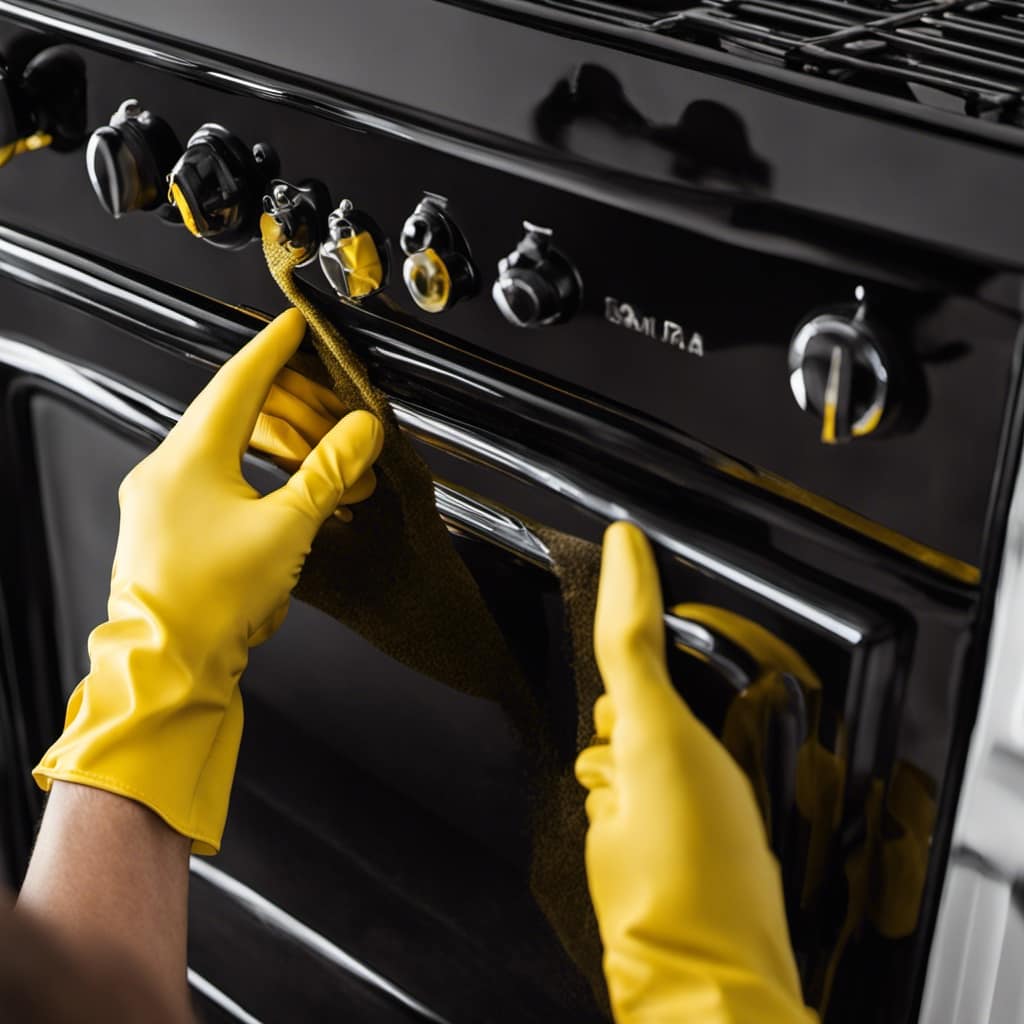
Now, let’s move on to the next important step – choosing the right cleaner for your wood stove.
Choosing the Right Cleaner
When it comes to selecting the appropriate cleaner for my wood stove, I consider the specific needs of the glass surface. The first thing I look for are safe and eco-friendly cleaners that won’t harm the environment or my health.
There are many DIY glass cleaning solutions available that meet these criteria. One option is a mixture of vinegar and water. This solution is effective at removing dirt and grime from the glass without leaving streaks.
Another option is using baking soda and water to create a paste. This paste can be applied to the glass and then wiped away with a damp cloth.
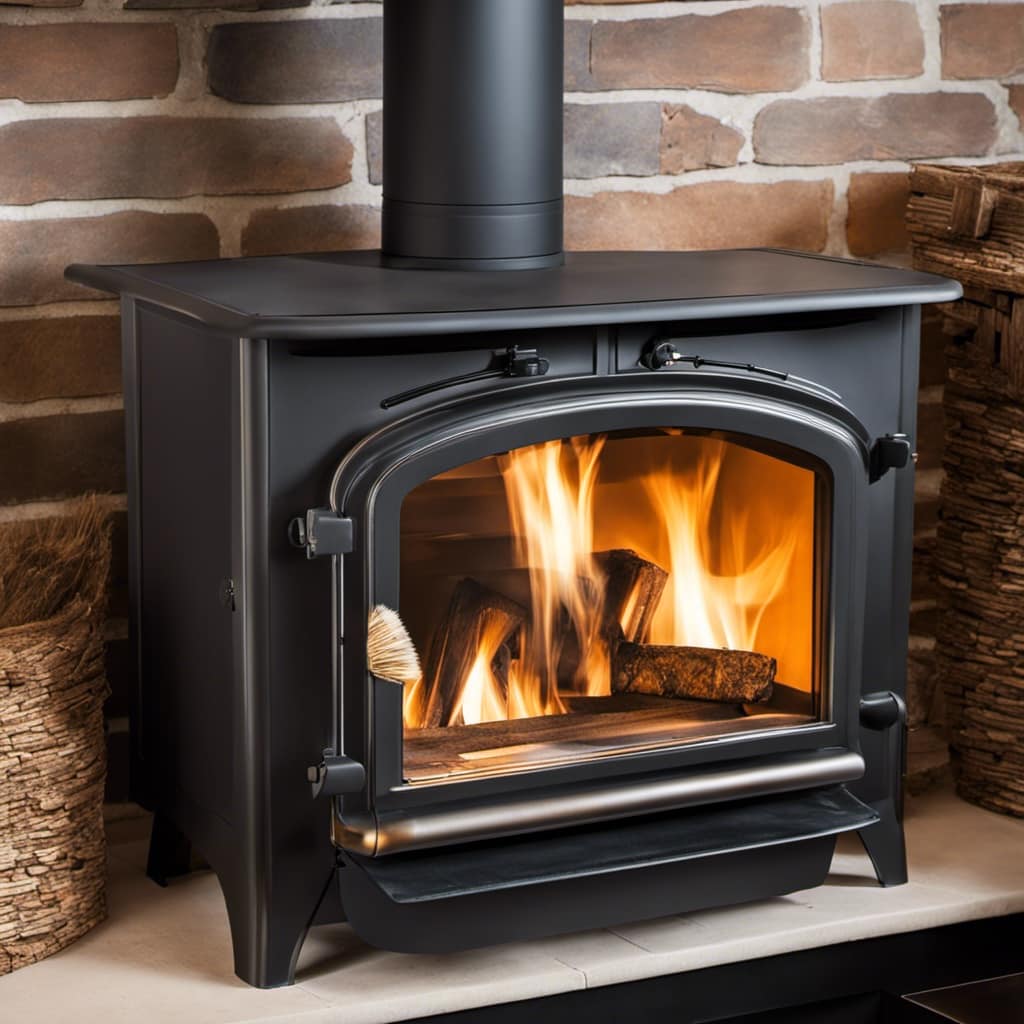
Both of these homemade solutions are affordable, easy to make, and gentle on the glass surface.
Maintaining Clean Glass for Future Use
As I clean the glass on my wood stove, I can easily maintain its cleanliness for future use. By following a few simple steps, I ensure that the glass remains clear and free from soot and residue, allowing me to enjoy the mesmerizing flames without obstruction.
Here are some tips for long-term glass care:
-
Regular cleaning: I make it a habit to clean the glass after each use to prevent the buildup of deposits. This helps maintain its transparency and prevents stubborn stains from forming.
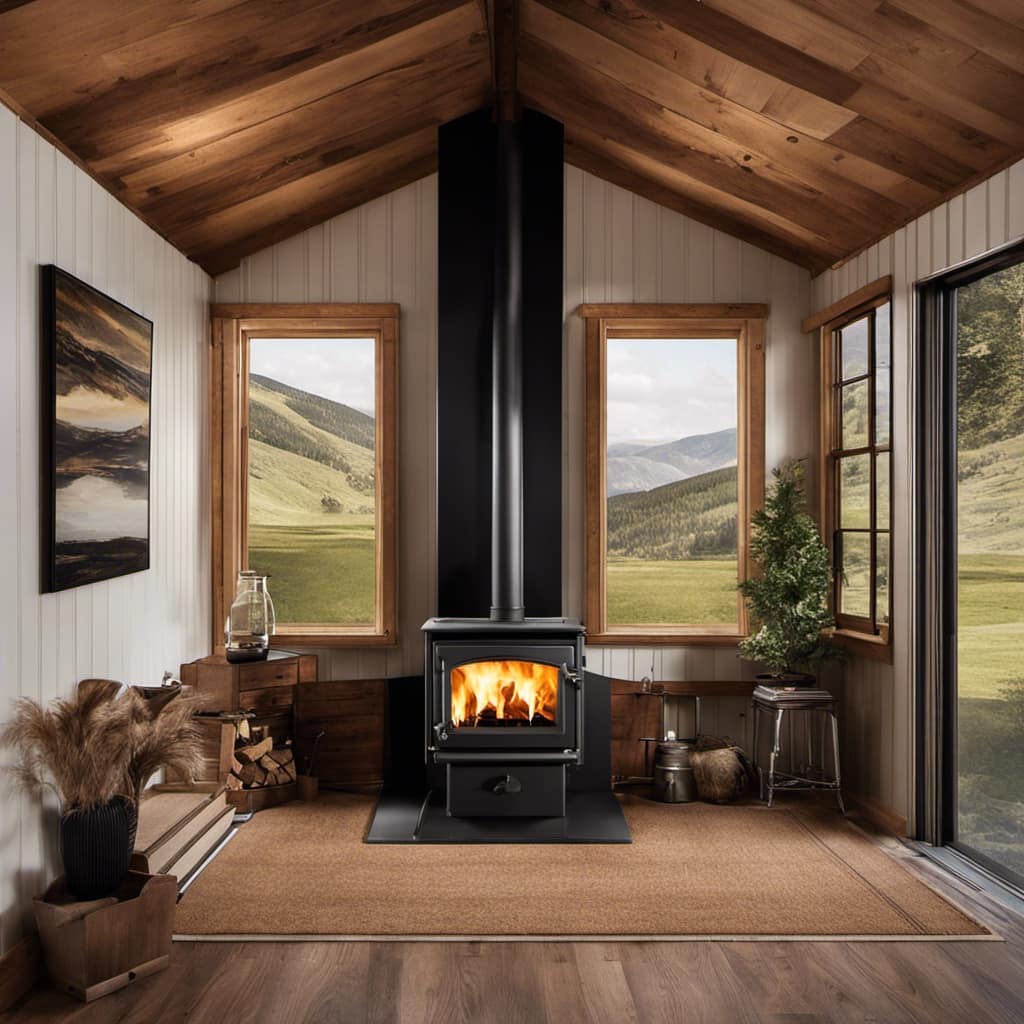
-
Gentle cleaning solutions: I opt for mild cleaners specifically designed for wood stove glass. These cleaners effectively remove soot and grime without damaging the glass surface.
-
Soft cloth or sponge: I use a soft cloth or sponge to gently scrub the glass, ensuring that I don’t scratch or damage it. Avoid abrasive materials that can leave scratches or marks.
-
Proper ventilation: Adequate ventilation is crucial for minimizing the accumulation of soot and keeping the glass clean. I ensure that my wood stove is properly ventilated to reduce the amount of residue that settles on the glass.
-
Regular maintenance: In addition to cleaning, I also inspect the gaskets and seals regularly to ensure they’re in good condition. This helps prevent air leaks that can cause soot buildup on the glass.

Frequently Asked Questions
How Often Should I Clean the Glass on My Wood Stove?
I clean the glass on my wood stove regularly to ensure it remains clear and free from streaks.
It’s important to maintain the cleanliness of the glass for optimal visibility and efficiency. By regularly cleaning the glass, you can prevent buildup of soot and other residues that can affect the performance of the stove.
Additionally, cleaning the glass without leaving streaks can be achieved by using a specialized glass cleaner and a soft cloth or sponge.
Can I Use Regular Glass Cleaner to Clean the Glass on My Wood Stove?
Can I use regular glass cleaner to clean the glass on my wood stove?
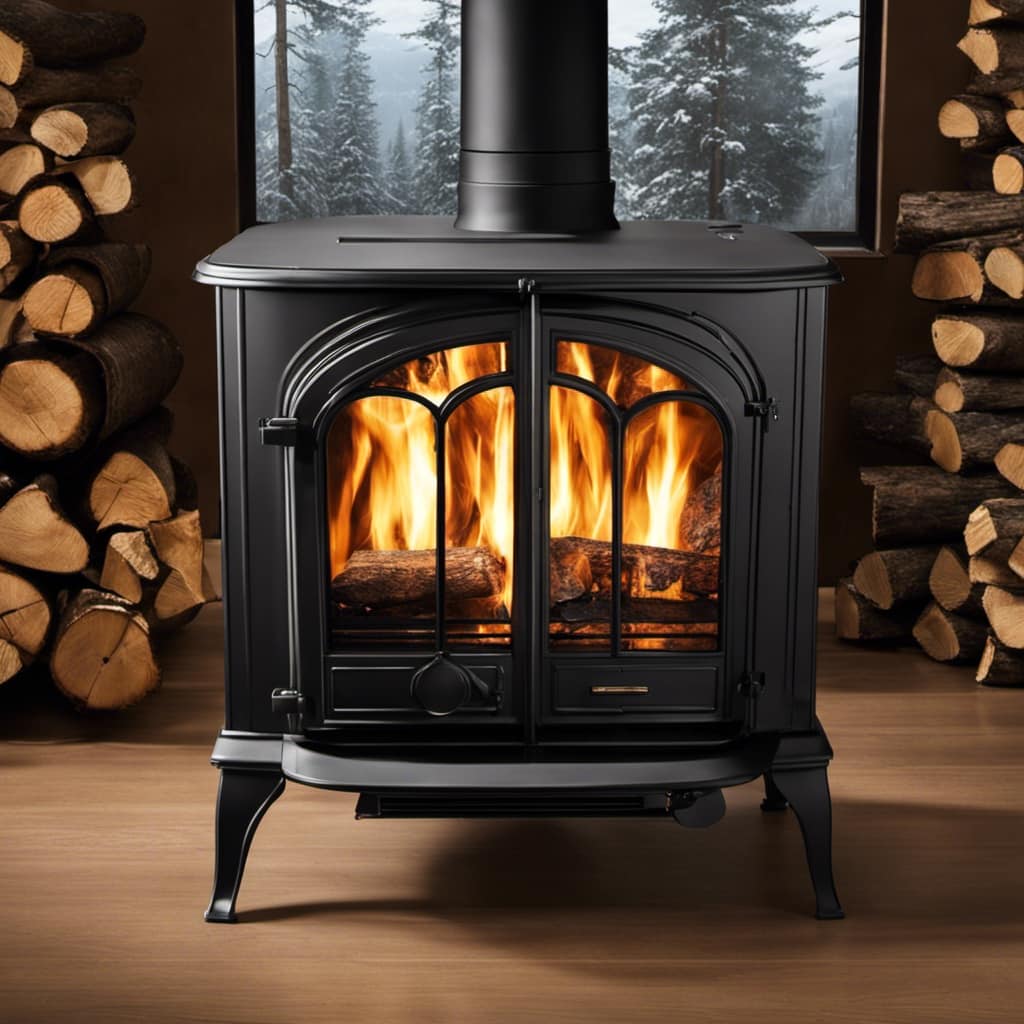
No, you should avoid using regular glass cleaner on your wood stove. Instead, opt for specialized cleaning methods for wood stoves.
Regular glass cleaners may contain chemicals that can be harmful when exposed to high heat.
To clean the glass on your wood stove effectively, consider using alternatives such as a mixture of vinegar and water or a commercial stove glass cleaner specifically designed for wood stoves.
Is It Safe to Use Abrasive Materials or Tools to Scrub Away Stubborn Stains on the Glass?
Safety precautions should always be considered when dealing with stubborn stains on the glass of a wood stove.
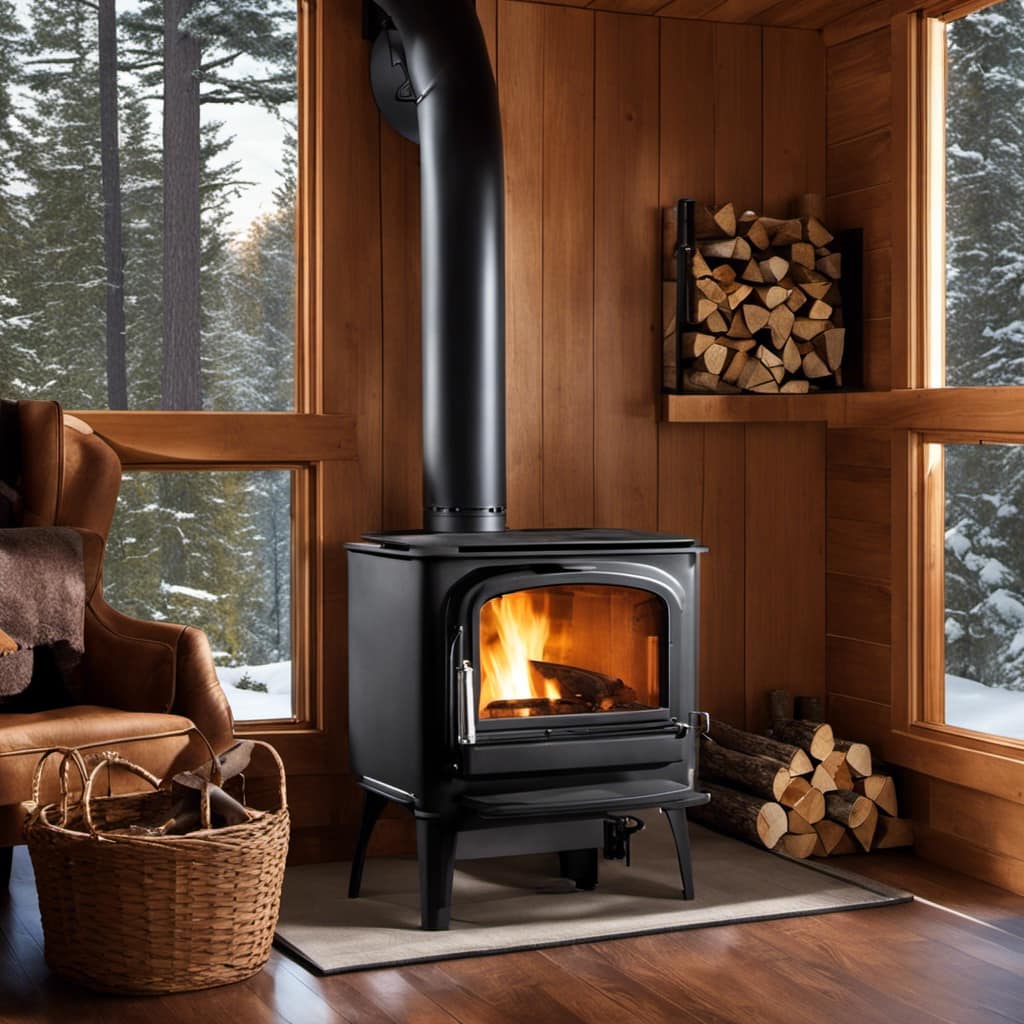
It isn’t safe to use abrasive materials or tools to scrub away these stains as they can damage the glass.
Instead, alternative cleaning methods should be used, such as using a mixture of vinegar and water or a specialized glass cleaner designed for wood stoves.
These methods are effective in removing stains while ensuring the safety and integrity of the glass.
Should I Clean the Glass on My Wood Stove While It Is Still Hot?
Should I clean the glass on my wood stove while it’s still hot?

It’s essential to prioritize safety when cleaning the glass on a wood stove. Cleaning the glass while it’s hot can lead to burns and other accidents. Wait for the stove to cool down before starting the cleaning process.
When it comes to cleaning techniques, using a non-abrasive cloth or sponge along with a specialized glass cleaner is recommended. These products are designed to effectively remove soot and stains without damaging the glass.
What Can I Do to Prevent Future Buildup and Stains on the Glass of My Wood Stove?
To prevent future buildup and stains on the glass of my wood stove, I’ve found a few useful cleaning hacks.
First, I make sure to burn only well-seasoned wood, as wet or unseasoned wood can produce more smoke and residue.

Additionally, I regularly clean the inside of the stove to minimize the amount of soot and ash that can accumulate on the glass.
Lastly, I use a specialized glass cleaner and a soft cloth to effectively remove any stubborn stains.
Conclusion
In conclusion, maintaining clean glass on a wood stove is crucial for optimal performance and aesthetic appeal.
By using natural cleaning solutions and following the proper steps, you can easily remove stubborn stains and restore the glass to its original clarity.
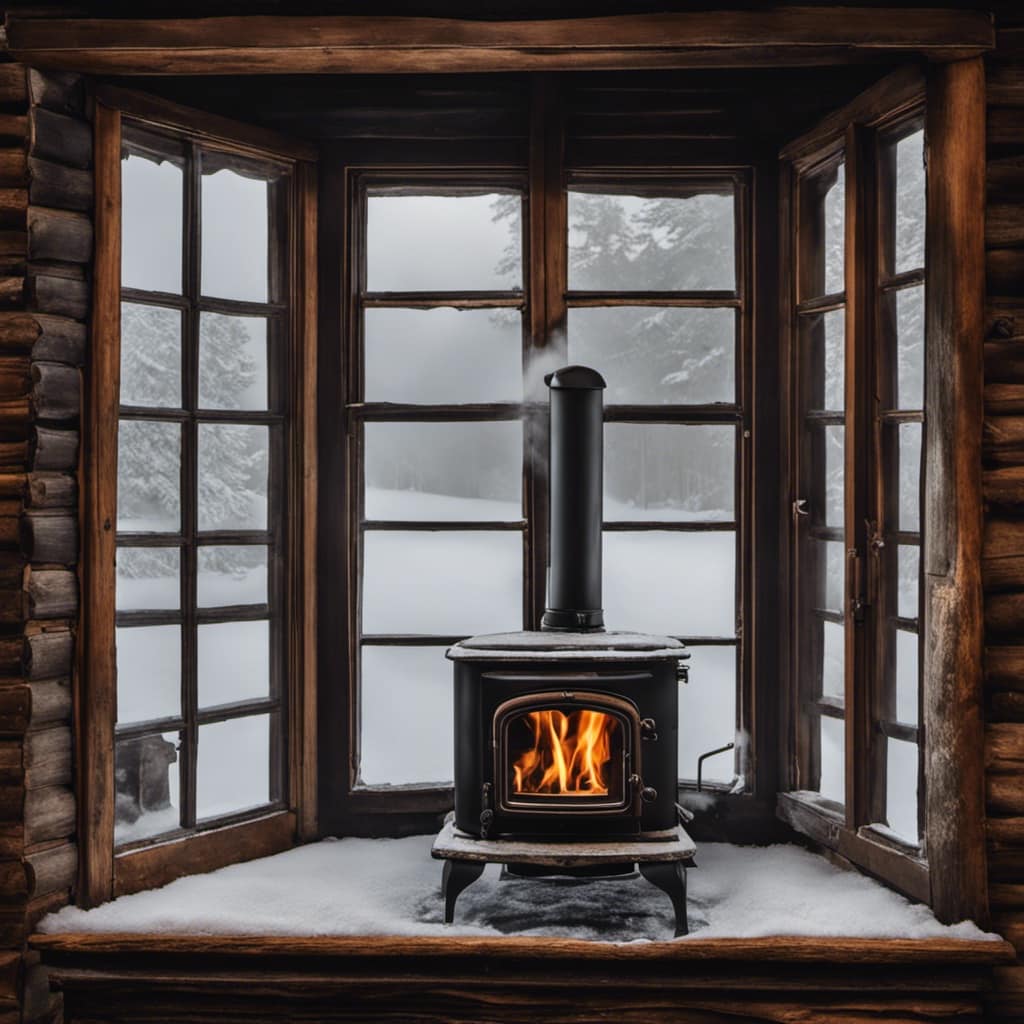
Regular maintenance and polishing will keep the glass looking pristine and ensure a clear view of the mesmerizing flames inside.
With a little effort, your wood stove will continue to be a cozy centerpiece in your home.
Growing up surrounded by the vast beauty of nature, Sierra was always drawn to the call of the wild. While others sought the comfort of the familiar, she ventured out, embracing the unpredictable and finding stories in the heartbeat of nature.
At the epicenter of every remarkable venture lies a dynamic team—a fusion of diverse talents, visions, and passions. The essence of Best Small Wood Stoves is crafted and refined by such a trio: Sierra, Logan, and Terra. Their collective expertise has transformed the platform into a leading authority on small wood stoves, radiating warmth and knowledge in equal measure.



